The larynx, also commonly called the voice box, is a cylindrical space located in the neck Neck The part of a human or animal body connecting the head to the rest of the body. Peritonsillar Abscess at the level of the C3–C6 vertebrae. The larynx is continuous superiorly with the pharynx Pharynx The pharynx is a component of the digestive system that lies posterior to the nasal cavity, oral cavity, and larynx. The pharynx can be divided into the oropharynx, nasopharynx, and laryngopharynx. Pharyngeal muscles play an integral role in vital processes such as breathing, swallowing, and speaking. Pharynx: Anatomy and inferiorly with the trachea Trachea The trachea is a tubular structure that forms part of the lower respiratory tract. The trachea is continuous superiorly with the larynx and inferiorly becomes the bronchial tree within the lungs. The trachea consists of a support frame of semicircular, or C-shaped, rings made out of hyaline cartilage and reinforced by collagenous connective tissue. Trachea: Anatomy. This structure is made up of 9 cartilages that are connected by membranes, ligaments, and muscles and that house the vocal cords. The major structures forming the framework of the larynx are the thyroid Thyroid The thyroid gland is one of the largest endocrine glands in the human body. The thyroid gland is a highly vascular, brownish-red gland located in the visceral compartment of the anterior region of the neck. Thyroid Gland: Anatomy cartilage Cartilage Cartilage is a type of connective tissue derived from embryonic mesenchyme that is responsible for structural support, resilience, and the smoothness of physical actions. Perichondrium (connective tissue membrane surrounding cartilage) compensates for the absence of vasculature in cartilage by providing nutrition and support. Cartilage: Histology, cricoid cartilage Cartilage Cartilage is a type of connective tissue derived from embryonic mesenchyme that is responsible for structural support, resilience, and the smoothness of physical actions. Perichondrium (connective tissue membrane surrounding cartilage) compensates for the absence of vasculature in cartilage by providing nutrition and support. Cartilage: Histology, and epiglottis. The larynx serves to produce sound (phonation), conducts air to the trachea Trachea The trachea is a tubular structure that forms part of the lower respiratory tract. The trachea is continuous superiorly with the larynx and inferiorly becomes the bronchial tree within the lungs. The trachea consists of a support frame of semicircular, or C-shaped, rings made out of hyaline cartilage and reinforced by collagenous connective tissue. Trachea: Anatomy, and prevents large molecules from reaching the lungs Lungs Lungs are the main organs of the respiratory system. Lungs are paired viscera located in the thoracic cavity and are composed of spongy tissue. The primary function of the lungs is to oxygenate blood and eliminate CO2. Lungs: Anatomy.
Last updated: Dec 15, 2025
The larynx is a framework composed mainly of cartilages held together by muscles and ligaments, both of which are divided into intrinsic and extrinsic forms.
| Cartilage Cartilage Cartilage is a type of connective tissue derived from embryonic mesenchyme that is responsible for structural support, resilience, and the smoothness of physical actions. Perichondrium (connective tissue membrane surrounding cartilage) compensates for the absence of vasculature in cartilage by providing nutrition and support. Cartilage: Histology | Unpaired |
|
|---|---|---|
| Paired |
|
|
| Ligaments | Extrinsic |
|
| Intrinsic |
|
|
| Muscles | Extrinsic |
|
| Intrinsic |
|
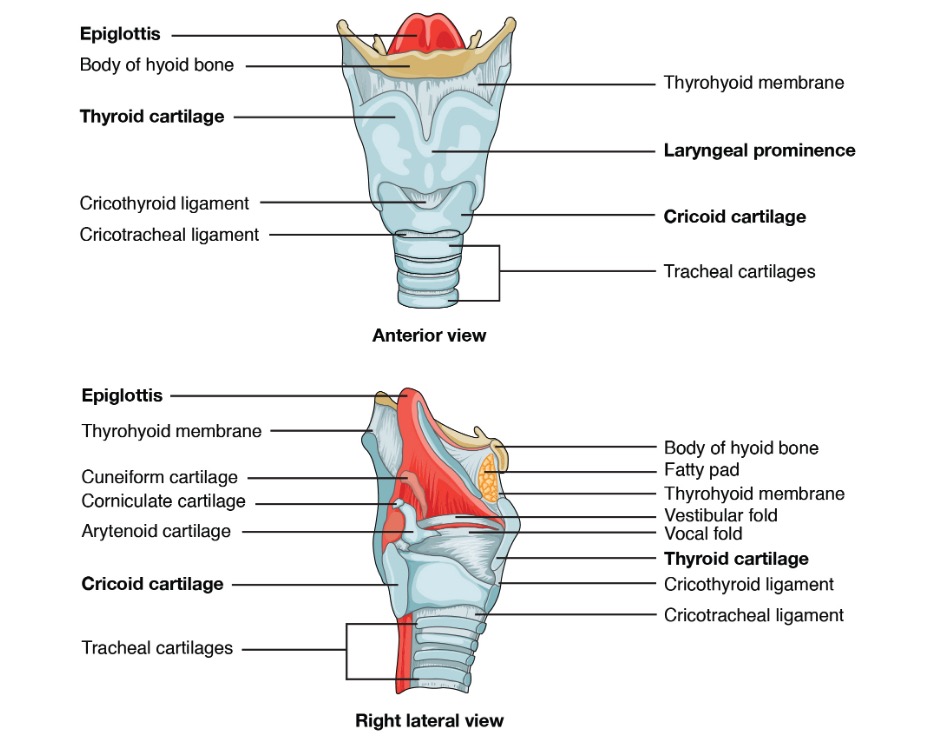
Anterior (top) and right lateral (bottom) views of the larynx, displaying its anatomical landmarks
Image: “Larynx” by OpenStax. License: CC BY 4.0Joints of the larynx:
Regions of the larynx:
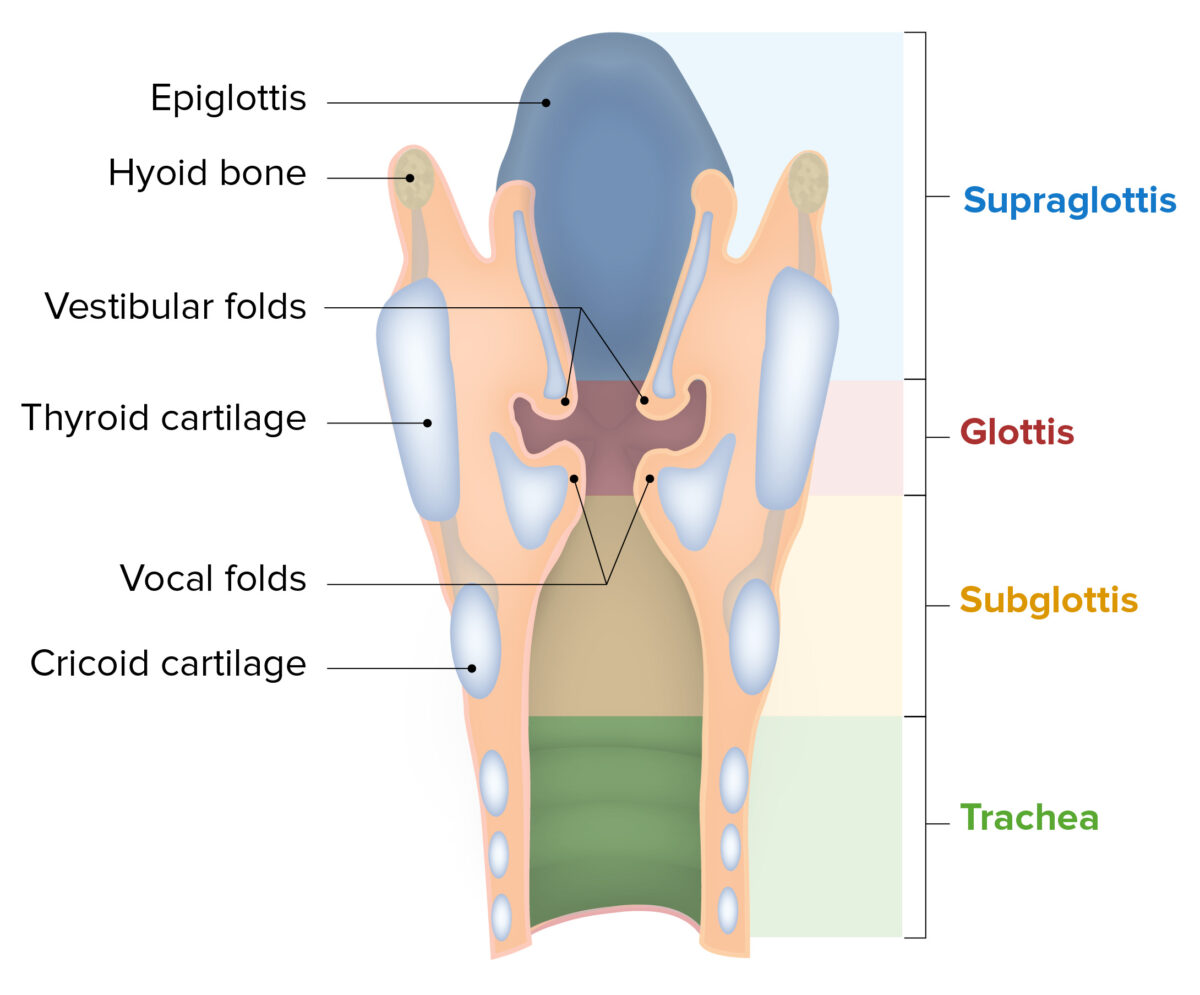
Components and regions of the larynx
Image by Lecturio.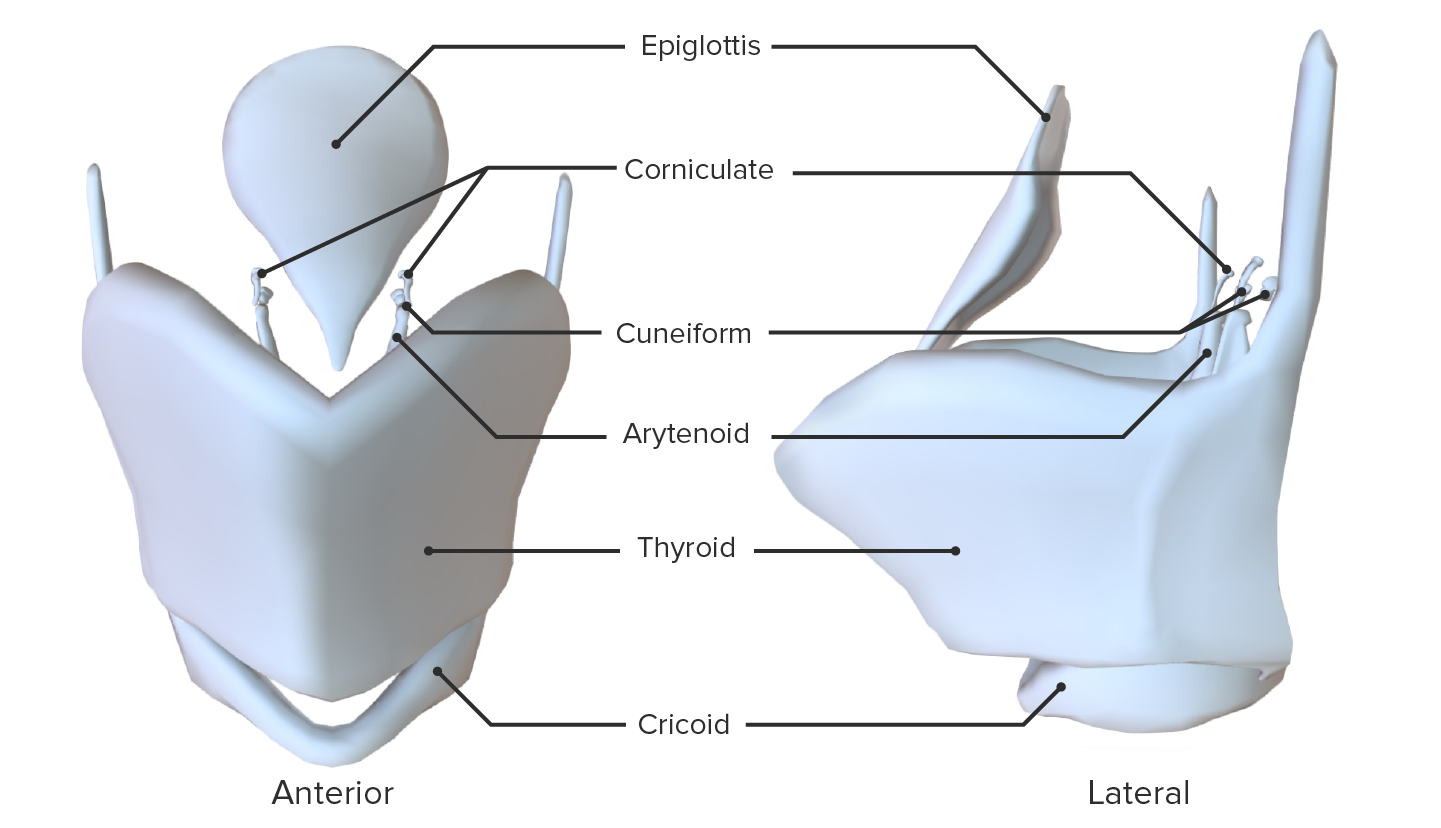
Anterior and lateral views of the isolated cartilages of the larynx
Image by Lecturio.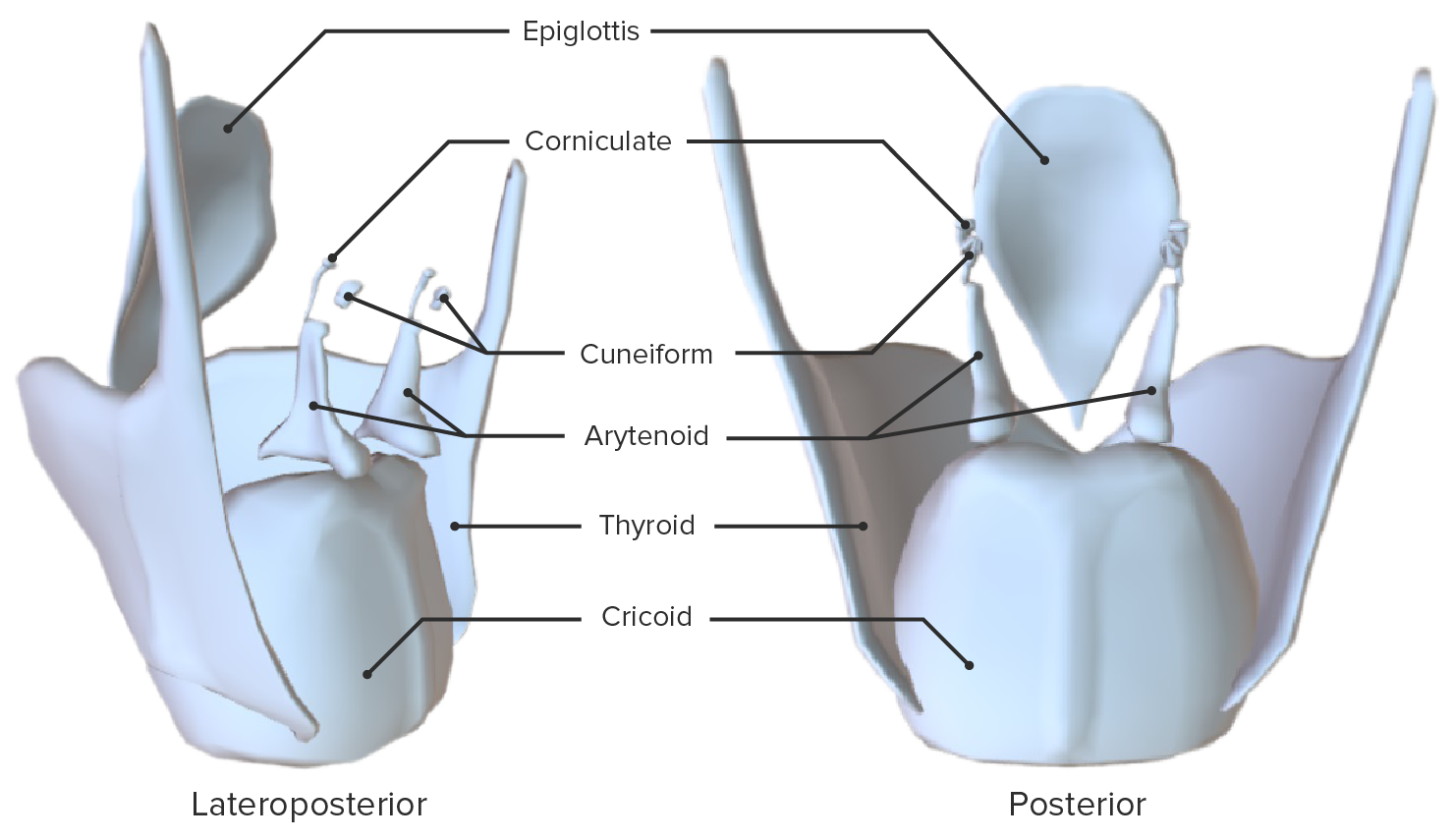
Lateroposterior and posterior views of the isolated cartilages of the larynx
Image by Lecturio.The ligaments and membranes of the larynx are responsible for connecting the cartilages and forming 1 single fibrocartilaginous structure. The membranes also fold over and enclose certain cartilages and membranes to comprise the moving and functional parts of the larynx (e.g., vocal cords).
Thyrohyoid membrane:
Hyoepiglottic ligament:
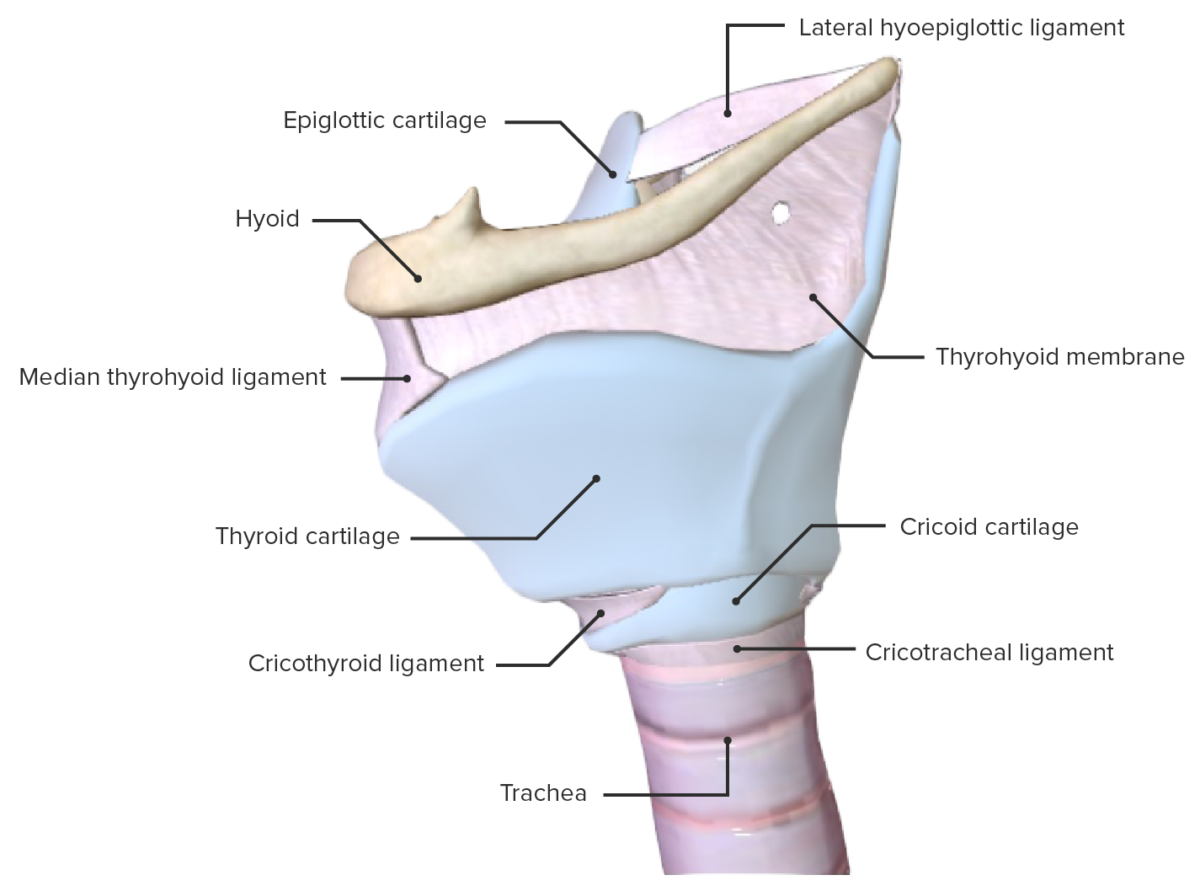
Lateral view of the larynx, featuring the membranes and cartilages
Image by Lecturio.Cricothyroid ligament:
Vocal ligaments:
Quadrangular membrane:
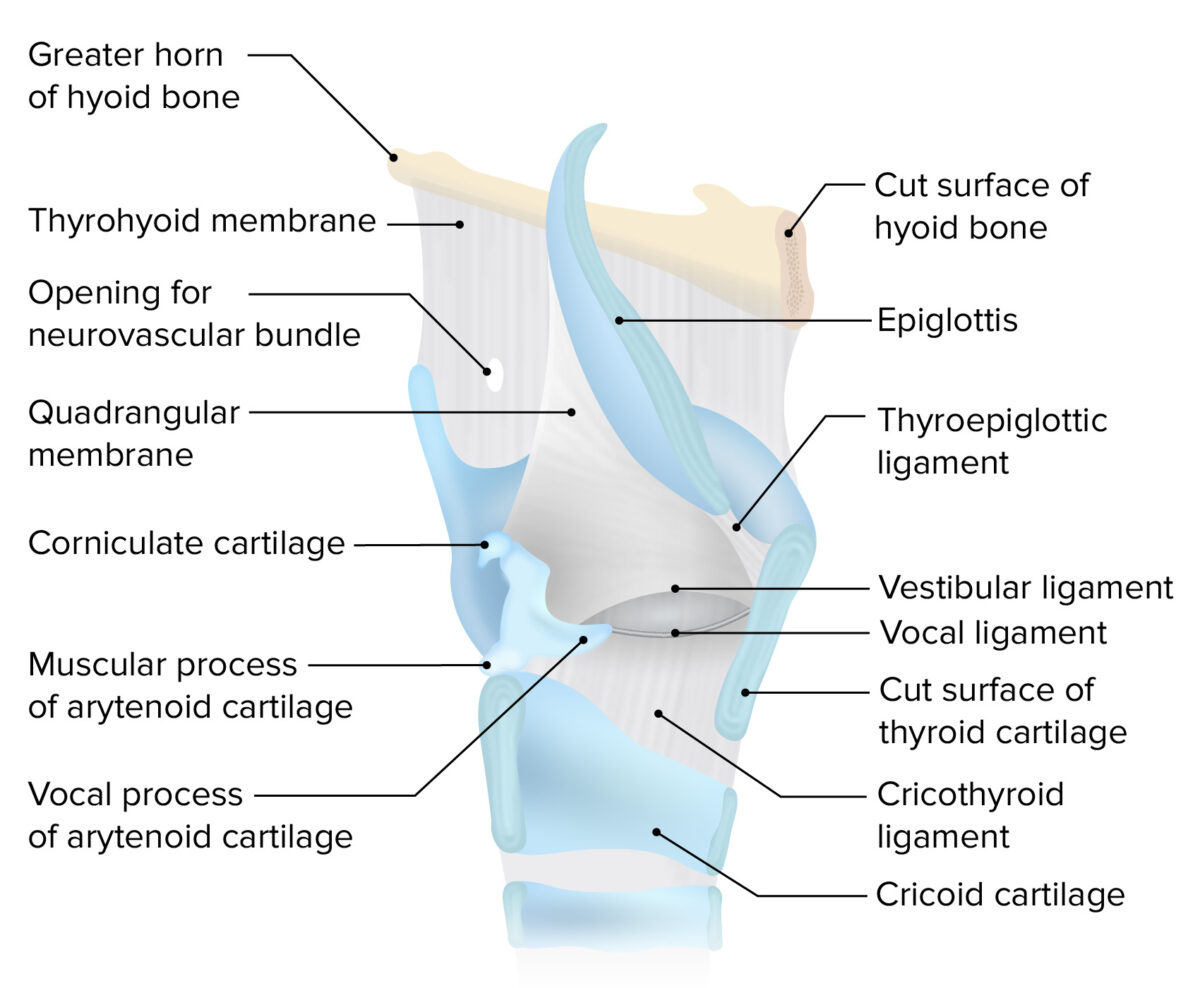
The ligaments and membranes of the larynx
Image by Lecturio.Suprahyoid group:
The suprahyoid laryngeal muscles are characterized by their location above the hyoid bone Bone Bone is a compact type of hardened connective tissue composed of bone cells, membranes, an extracellular mineralized matrix, and central bone marrow. The 2 primary types of bone are compact and spongy. Bones: Structure and Types and function of elevating the hyoid bone Bone Bone is a compact type of hardened connective tissue composed of bone cells, membranes, an extracellular mineralized matrix, and central bone marrow. The 2 primary types of bone are compact and spongy. Bones: Structure and Types and larynx during swallowing Swallowing The act of taking solids and liquids into the gastrointestinal tract through the mouth and throat. Gastrointestinal Motility and phonation.
| Muscle | Origin | Insertion | Innervation |
|---|---|---|---|
| Stylohyoid | Styloid process of the temporal bone Temporal bone Either of a pair of compound bones forming the lateral (left and right) surfaces and base of the skull which contains the organs of hearing. It is a large bone formed by the fusion of parts: the squamous (the flattened anterior-superior part), the tympanic (the curved anterior-inferior part), the mastoid (the irregular posterior portion), and the petrous (the part at the base of the skull). Jaw and Temporomandibular Joint: Anatomy | Body of the hyoid bone Bone Bone is a compact type of hardened connective tissue composed of bone cells, membranes, an extracellular mineralized matrix, and central bone marrow. The 2 primary types of bone are compact and spongy. Bones: Structure and Types | Facial nerve Facial nerve The 7th cranial nerve. The facial nerve has two parts, the larger motor root which may be called the facial nerve proper, and the smaller intermediate or sensory root. Together they provide efferent innervation to the muscles of facial expression and to the lacrimal and salivary glands, and convey afferent information for taste from the anterior two-thirds of the tongue and for touch from the external ear. The 12 Cranial Nerves: Overview and Functions |
| Digastric | Anterior belly: digastric fossa of the mandible Mandible The largest and strongest bone of the face constituting the lower jaw. It supports the lower teeth. Jaw and Temporomandibular Joint: Anatomy | Anterior and posterior bellies: intermediate tendon | Anterior belly: mylohyoid nerve, branch of the mandibular nerve Mandibular nerve A branch of the trigeminal (5th cranial) nerve. The mandibular nerve carries motor fibers to the muscles of mastication and sensory fibers to the teeth and gingivae, the face in the region of the mandible, and parts of the dura. Jaw and Temporomandibular Joint: Anatomy |
| Posterior belly: mastoid notch of the temporal bone Temporal bone Either of a pair of compound bones forming the lateral (left and right) surfaces and base of the skull which contains the organs of hearing. It is a large bone formed by the fusion of parts: the squamous (the flattened anterior-superior part), the tympanic (the curved anterior-inferior part), the mastoid (the irregular posterior portion), and the petrous (the part at the base of the skull). Jaw and Temporomandibular Joint: Anatomy | Posterior belly: facial nerve Facial nerve The 7th cranial nerve. The facial nerve has two parts, the larger motor root which may be called the facial nerve proper, and the smaller intermediate or sensory root. Together they provide efferent innervation to the muscles of facial expression and to the lacrimal and salivary glands, and convey afferent information for taste from the anterior two-thirds of the tongue and for touch from the external ear. The 12 Cranial Nerves: Overview and Functions | ||
| Mylohyoid | Mylohyoid line of mandible Mandible The largest and strongest bone of the face constituting the lower jaw. It supports the lower teeth. Jaw and Temporomandibular Joint: Anatomy | Body of the hyoid bone Bone Bone is a compact type of hardened connective tissue composed of bone cells, membranes, an extracellular mineralized matrix, and central bone marrow. The 2 primary types of bone are compact and spongy. Bones: Structure and Types and median raphe Raphe Testicles: Anatomy | Mylohyoid nerve, branch of the mandibular nerve Mandibular nerve A branch of the trigeminal (5th cranial) nerve. The mandibular nerve carries motor fibers to the muscles of mastication and sensory fibers to the teeth and gingivae, the face in the region of the mandible, and parts of the dura. Jaw and Temporomandibular Joint: Anatomy |
| Geniohyoid | Mental spine Spine The human spine, or vertebral column, is the most important anatomical and functional axis of the human body. It consists of 7 cervical vertebrae, 12 thoracic vertebrae, and 5 lumbar vertebrae and is limited cranially by the skull and caudally by the sacrum. Vertebral Column: Anatomy of the inner surface of the mandible Mandible The largest and strongest bone of the face constituting the lower jaw. It supports the lower teeth. Jaw and Temporomandibular Joint: Anatomy | Body of the hyoid bone Bone Bone is a compact type of hardened connective tissue composed of bone cells, membranes, an extracellular mineralized matrix, and central bone marrow. The 2 primary types of bone are compact and spongy. Bones: Structure and Types | C1–C2 of the cervical plexus Cervical Plexus A network of nerve fibers originating in the upper four cervical spinal cord segments. The cervical plexus distributes cutaneous nerves to parts of the neck, shoulders, and back of the head. It also distributes motor fibers to muscles of the cervical spinal column, infrahyoid muscles, and the diaphragm. Peripheral Nerve Injuries in the Cervicothoracic Region and the hypoglossal nerve Hypoglossal nerve The 12th cranial nerve. The hypoglossal nerve originates in the hypoglossal nucleus of the medulla and supplies motor innervation to all of the muscles of the tongue except the palatoglossus (which is supplied by the vagus). This nerve also contains proprioceptive afferents from the tongue muscles. Lips and Tongue: Anatomy |
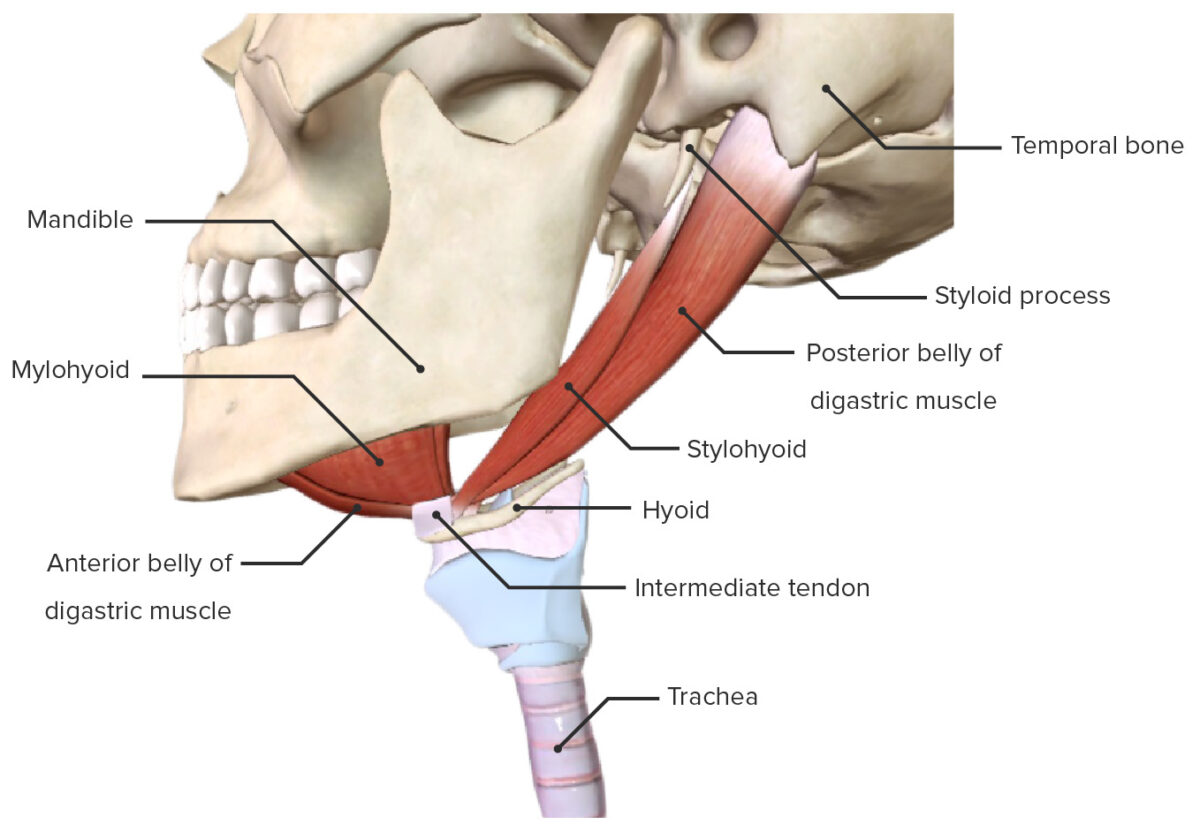
The suprahyoid group of the extrinsic laryngeal muscles:
The geniohyoid muscle is not shown.
Infrahyoid group:
The infrahyoid laryngeal muscles are characterized by their location below the hyoid bone Bone Bone is a compact type of hardened connective tissue composed of bone cells, membranes, an extracellular mineralized matrix, and central bone marrow. The 2 primary types of bone are compact and spongy. Bones: Structure and Types and by their function of depressing the hyoid bone Bone Bone is a compact type of hardened connective tissue composed of bone cells, membranes, an extracellular mineralized matrix, and central bone marrow. The 2 primary types of bone are compact and spongy. Bones: Structure and Types and larynx during swallowing Swallowing The act of taking solids and liquids into the gastrointestinal tract through the mouth and throat. Gastrointestinal Motility and phonation.
| Muscle | Origin | Insertion | Innervation |
|---|---|---|---|
| Sternohyoid | Dorsal surface of the manubrium Manubrium The upper or most anterior segment of the sternum which articulates with the clavicle and first two pairs of ribs. Chest Wall: Anatomy and the sternoclavicular joint Sternoclavicular Joint Examination of the Upper Limbs | Body of the hyoid bone Bone Bone is a compact type of hardened connective tissue composed of bone cells, membranes, an extracellular mineralized matrix, and central bone marrow. The 2 primary types of bone are compact and spongy. Bones: Structure and Types | C1–C3 of the cervical plexus Cervical Plexus A network of nerve fibers originating in the upper four cervical spinal cord segments. The cervical plexus distributes cutaneous nerves to parts of the neck, shoulders, and back of the head. It also distributes motor fibers to muscles of the cervical spinal column, infrahyoid muscles, and the diaphragm. Peripheral Nerve Injuries in the Cervicothoracic Region |
| Omohyoid |
|
Body of the hyoid bone Bone Bone is a compact type of hardened connective tissue composed of bone cells, membranes, an extracellular mineralized matrix, and central bone marrow. The 2 primary types of bone are compact and spongy. Bones: Structure and Types (connected to the carotid sheath) | |
| Sternothyroid | Dorsal surface of the manubrium Manubrium The upper or most anterior segment of the sternum which articulates with the clavicle and first two pairs of ribs. Chest Wall: Anatomy | Oblique line of the thyroid Thyroid The thyroid gland is one of the largest endocrine glands in the human body. The thyroid gland is a highly vascular, brownish-red gland located in the visceral compartment of the anterior region of the neck. Thyroid Gland: Anatomy cartilage Cartilage Cartilage is a type of connective tissue derived from embryonic mesenchyme that is responsible for structural support, resilience, and the smoothness of physical actions. Perichondrium (connective tissue membrane surrounding cartilage) compensates for the absence of vasculature in cartilage by providing nutrition and support. Cartilage: Histology | |
| Thyrohyoid (continuation of sternothyroid) | Oblique line of the thyroid Thyroid The thyroid gland is one of the largest endocrine glands in the human body. The thyroid gland is a highly vascular, brownish-red gland located in the visceral compartment of the anterior region of the neck. Thyroid Gland: Anatomy cartilage Cartilage Cartilage is a type of connective tissue derived from embryonic mesenchyme that is responsible for structural support, resilience, and the smoothness of physical actions. Perichondrium (connective tissue membrane surrounding cartilage) compensates for the absence of vasculature in cartilage by providing nutrition and support. Cartilage: Histology | Body and greater horns of the hyoid bone Bone Bone is a compact type of hardened connective tissue composed of bone cells, membranes, an extracellular mineralized matrix, and central bone marrow. The 2 primary types of bone are compact and spongy. Bones: Structure and Types | Hypoglossal nerve Hypoglossal nerve The 12th cranial nerve. The hypoglossal nerve originates in the hypoglossal nucleus of the medulla and supplies motor innervation to all of the muscles of the tongue except the palatoglossus (which is supplied by the vagus). This nerve also contains proprioceptive afferents from the tongue muscles. Lips and Tongue: Anatomy (cranial nerve XII), via the anterior rami of C1 |
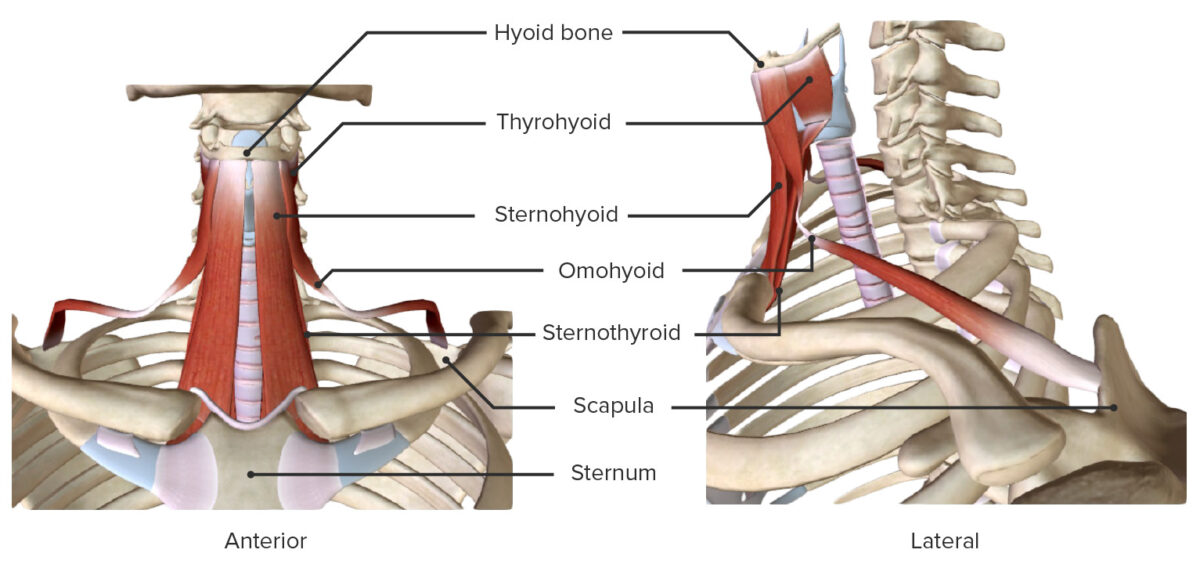
Anterior and lateral views of the infrahyoid group of the extrinsic laryngeal muscles
Image by BioDigital, edited by LecturioThe intrinsic laryngeal muscles serve to produce phonation by modifying the length and tension of the vocal cords and the size of the rima glottidis (the opening between the vocal cords).
| Muscle | Origin | Insertion | Innervation |
|---|---|---|---|
| Cricothyroid | Anterolateral portion of the cricoid |
|
External laryngeal nerve, branch of the superior laryngeal nerve |
| Thyroarytenoid | Angle of the thyroid Thyroid The thyroid gland is one of the largest endocrine glands in the human body. The thyroid gland is a highly vascular, brownish-red gland located in the visceral compartment of the anterior region of the neck. Thyroid Gland: Anatomy cartilage Cartilage Cartilage is a type of connective tissue derived from embryonic mesenchyme that is responsible for structural support, resilience, and the smoothness of physical actions. Perichondrium (connective tissue membrane surrounding cartilage) compensates for the absence of vasculature in cartilage by providing nutrition and support. Cartilage: Histology and cricothyroid ligament | Anterolateral surface of the arytenoids | Inferior laryngeal nerve, branch of the recurrent laryngeal nerve |
| Posterior cricoarytenoid | Posterior surface of the cricoid | Muscular process of the arytenoids | |
| Lateral cricoarytenoid | Arch of the cricoid | ||
| Transverse arytenoid | Lateral border and muscular process of the arytenoids | Lateral border and muscular process of the opposite arytenoid | |
| Oblique arytenoid | Muscular process of the arytenoids | Apex of the opposite arytenoid (with a prolongation to the aryepiglottic folds) | Recurrent laryngeal nerve |
| Vocalis | Lateral portions of the vocal processes of the arytenoids | Anterior portion of the ipsilateral vocal ligament |
|
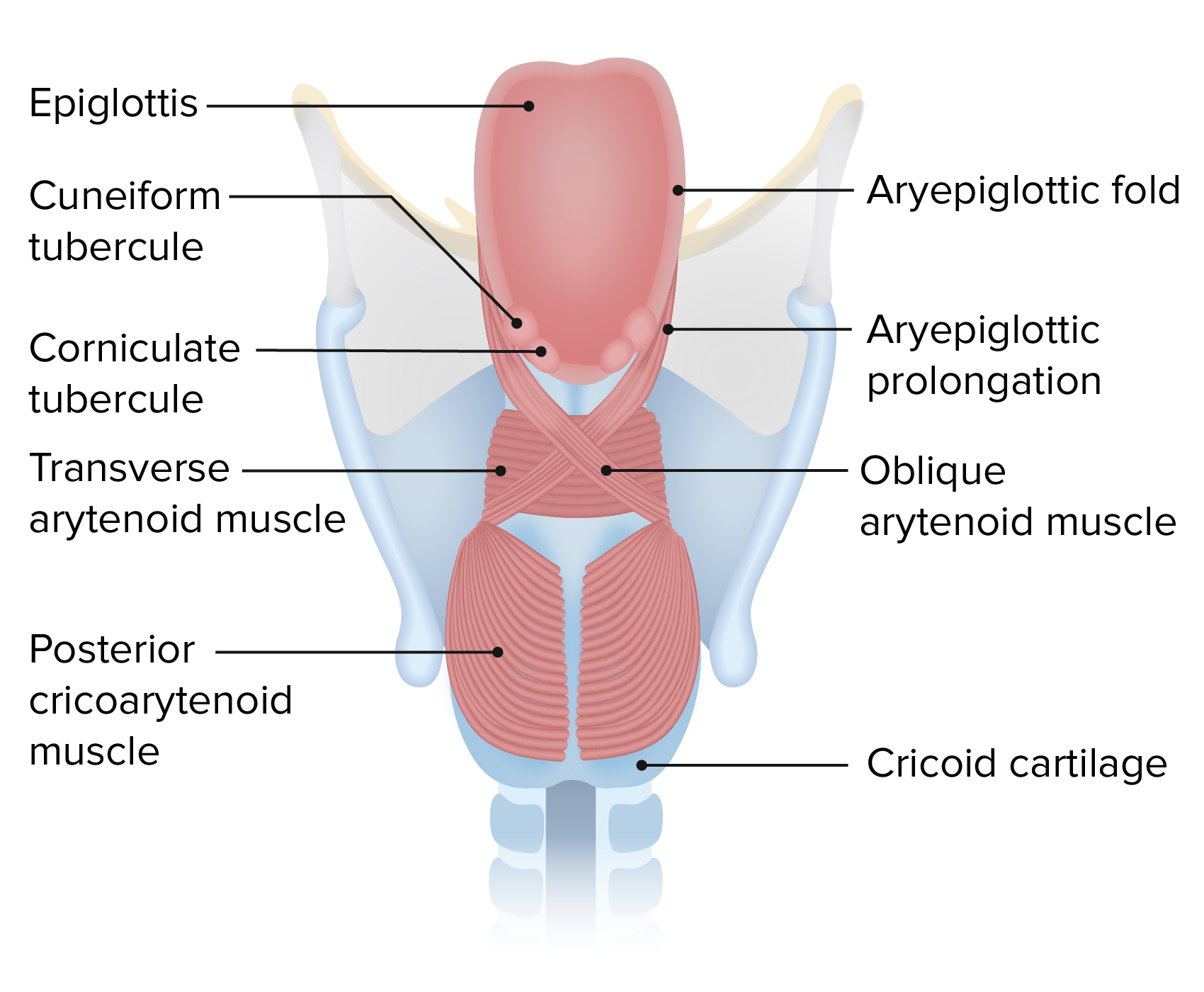
Posterior view of the intrinsic laryngeal muscles
Image by Lecturio.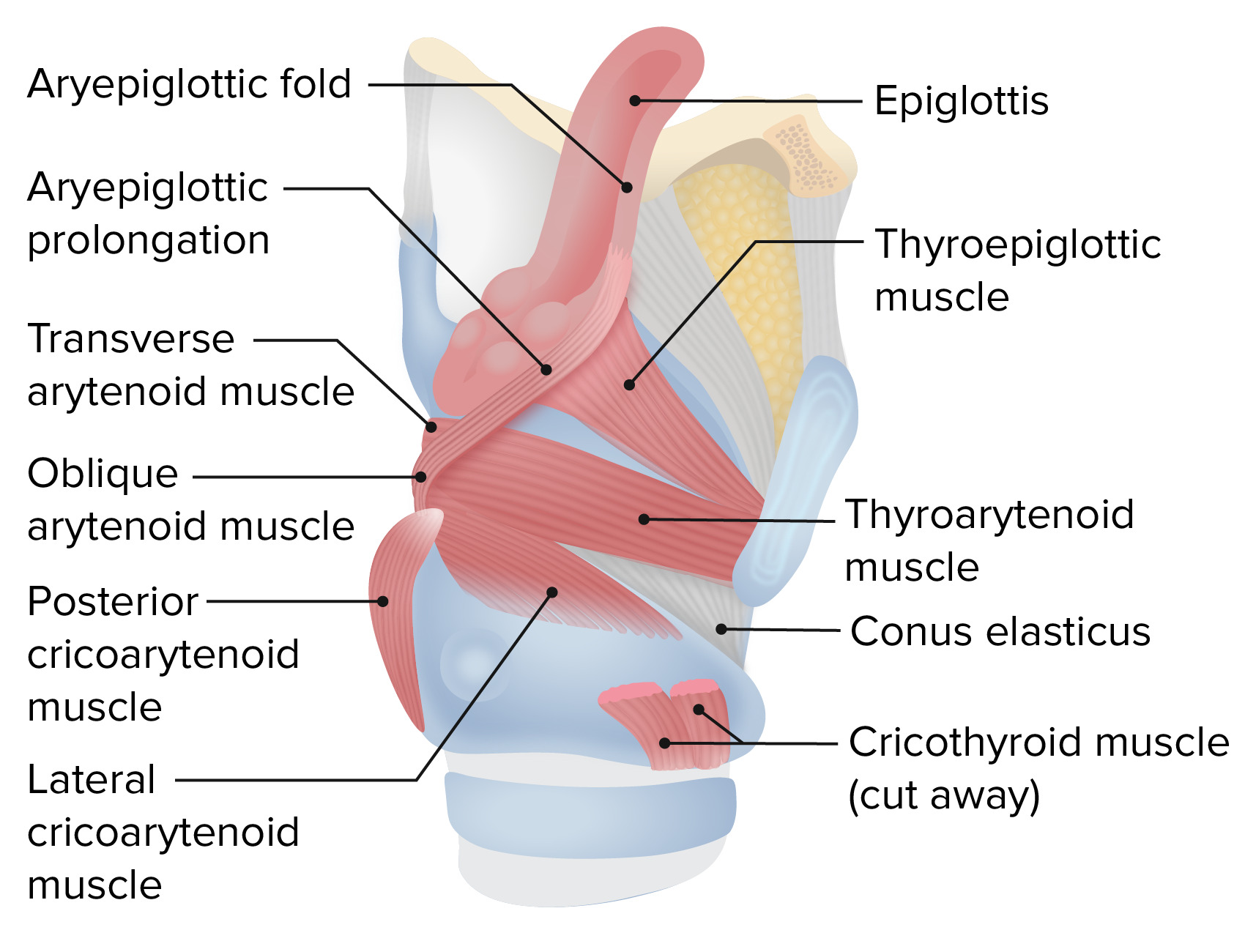
Lateral view of a sagittal dissection of the larynx, featuring the intrinsic laryngeal muscles
Image by Lecturio.
Superior view of the larynx showcasing the intrinsic laryngeal muscles
Image by Lecturio.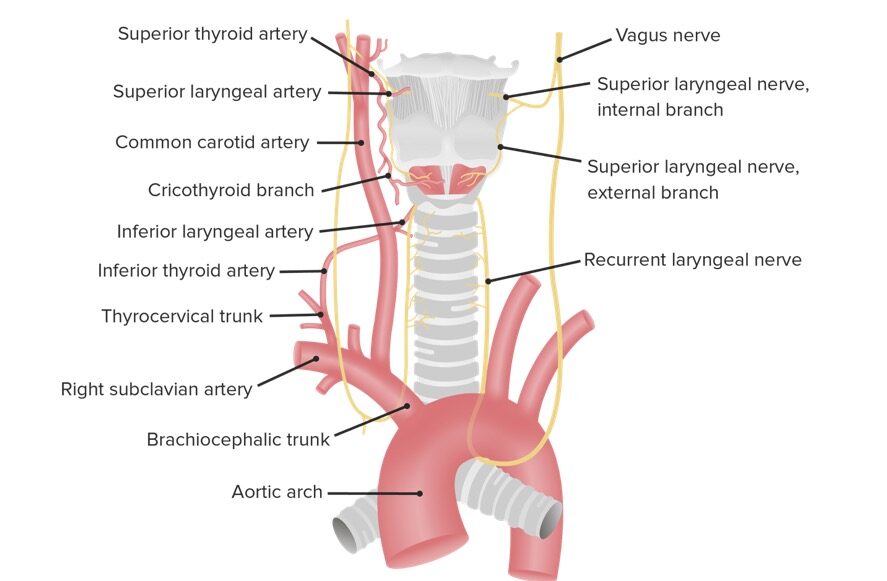
Larynx blood supply and innervation
Image by Lecturio.The innervation of the larynx is supplied by 2 branches of the vagus nerve Vagus nerve The 10th cranial nerve. The vagus is a mixed nerve which contains somatic afferents (from skin in back of the ear and the external auditory meatus), visceral afferents (from the pharynx, larynx, thorax, and abdomen), parasympathetic efferents (to the thorax and abdomen), and efferents to striated muscle (of the larynx and pharynx). Pharynx: Anatomy: the superior and inferior laryngeal nerves.
Superior laryngeal nerve:
Inferior laryngeal nerve:
Mnemonics:
| Muscle | Function |
|---|---|
| Cricothyroid |
|
| Posterior cricoarytenoid |
|
| Lateral cricoarytenoid |
|
| Transverse arytenoid |
|
| Oblique arytenoid |
|
| Thyroarytenoid | Sphincter of vestibule Vestibule An oval, bony chamber of the inner ear, part of the bony labyrinth. It is continuous with bony cochlea anteriorly, and semicircular canals posteriorly. The vestibule contains two communicating sacs (utricle and saccule) of the balancing apparatus. The oval window on its lateral wall is occupied by the base of the stapes of the middle ear. Ear: Anatomy and laryngeal inlet |
| Vocal muscle | Adjusts tension of the vocal folds |
Movements of the larynx:
Depending on the action (e.g., respiration Respiration The act of breathing with the lungs, consisting of inhalation, or the taking into the lungs of the ambient air, and of exhalation, or the expelling of the modified air which contains more carbon dioxide than the air taken in. Nose Anatomy (External & Internal), phonation, etc ETC The electron transport chain (ETC) sends electrons through a series of proteins, which generate an electrochemical proton gradient that produces energy in the form of adenosine triphosphate (ATP). Electron Transport Chain (ETC).), the laryngeal muscles regulate the movements of the vocal cords and determine the size of the rima glottidis, the opening between the vocal cords.
| Movements | ||
|---|---|---|
| Respiration Respiration The act of breathing with the lungs, consisting of inhalation, or the taking into the lungs of the ambient air, and of exhalation, or the expelling of the modified air which contains more carbon dioxide than the air taken in. Nose Anatomy (External & Internal) | In quiet
respiration
Respiration
The act of breathing with the lungs, consisting of inhalation, or the taking into the lungs of the ambient air, and of exhalation, or the expelling of the modified air which contains more carbon dioxide than the air taken in.
Nose Anatomy (External & Internal):
|
In forced
inspiration
Inspiration
Ventilation: Mechanics of Breathing:
|
| Phonation |
|
|
| Effort closure | Rima glottidis is completely closed. | |
| Swallowing Swallowing The act of taking solids and liquids into the gastrointestinal tract through the mouth and throat. Gastrointestinal Motility |
|
|
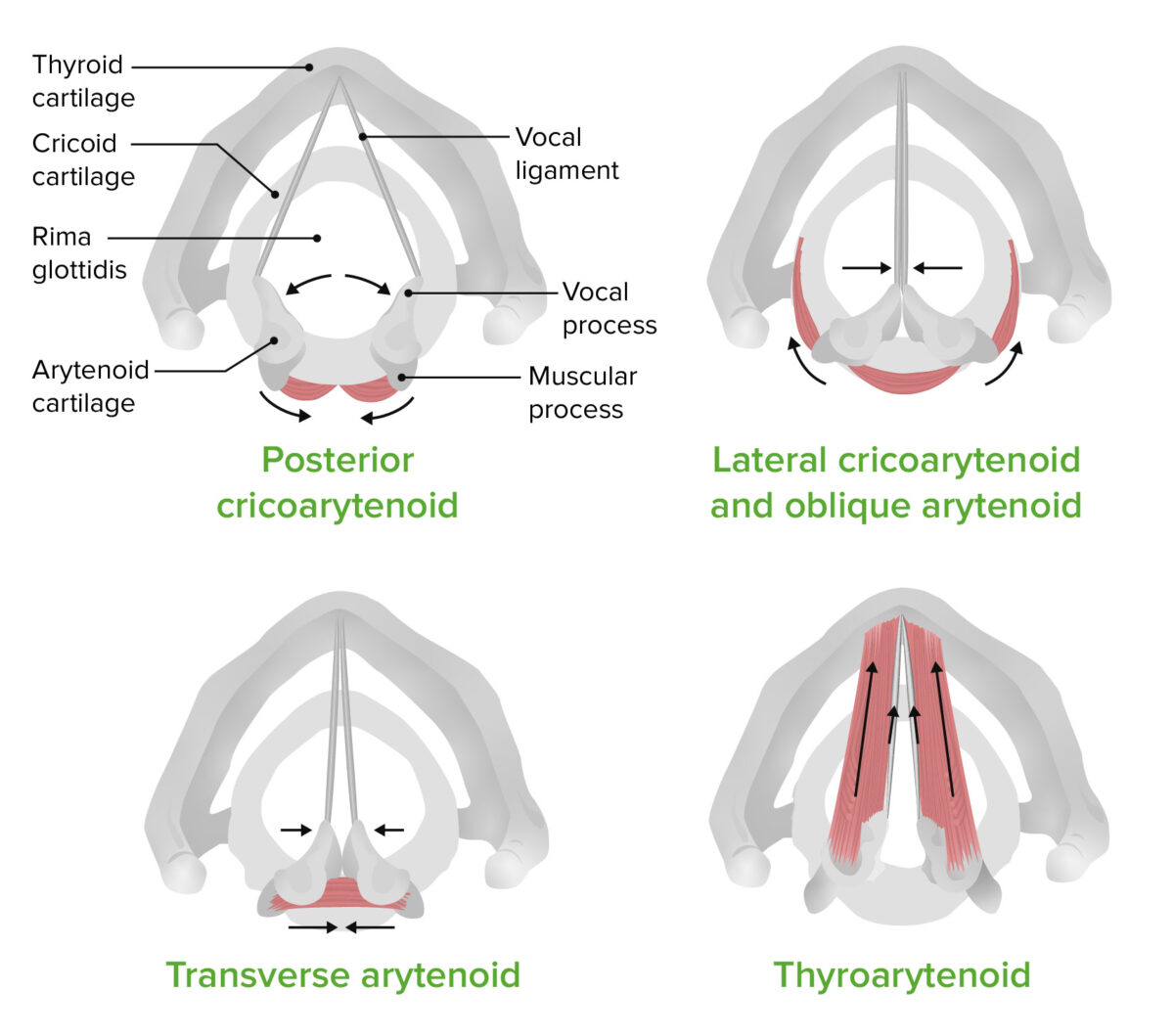
The functions of the intrinsic laryngeal muscles:
Note the effects on the vocal cords and the rima glottidis.
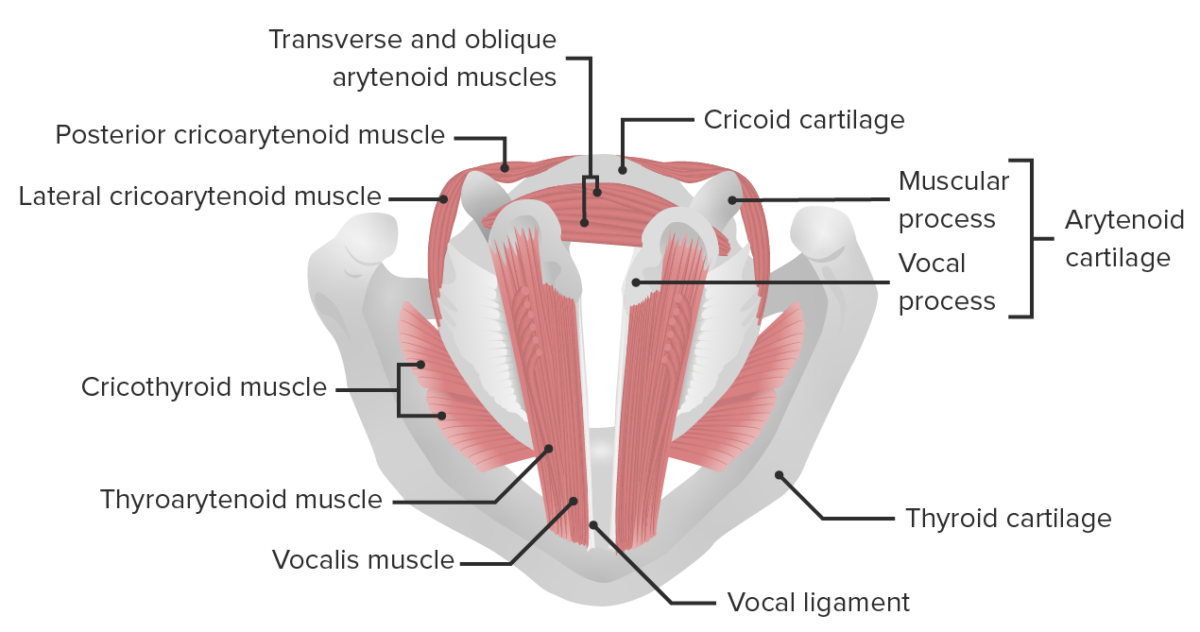
Intrinsic muscles of the larynx
Image by Lecturio.Laryngomalacia Laryngomalacia A congenital or acquired condition of underdeveloped or degeneration of cartilage in the larynx. This results in a floppy laryngeal wall making patency difficult to maintain. Laryngomalacia and Tracheomalacia: excessive flaccidity of the supraglottic larynx leads it to be sucked out of position during inspiration Inspiration Ventilation: Mechanics of Breathing, which can produce stridor Stridor Laryngomalacia and Tracheomalacia: This condition manifests at birth and disappears after 2 years of age.
Foreign body Foreign Body Foreign Body Aspiration aspiration: potentially life-threatening emergency that most commonly occurs in children ages 1–3 years. Presents as sudden onset of coughing, choking, stridor Stridor Laryngomalacia and Tracheomalacia, and dyspnea Dyspnea Dyspnea is the subjective sensation of breathing discomfort. Dyspnea is a normal manifestation of heavy physical or psychological exertion, but also may be caused by underlying conditions (both pulmonary and extrapulmonary). Dyspnea.